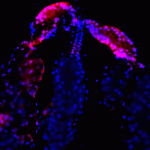Link to Pubmed [PMID] – 29723307
PLoS Pathog. 2018 May;14(5):e1006965
Despite estimates that, each year, as many as 300 million dengue virus (DENV) infections result in either no perceptible symptoms (asymptomatic) or symptoms that are sufficiently mild to go undetected by surveillance systems (inapparent), it has been assumed that these infections contribute little to onward transmission. However, recent blood-feeding experiments with Aedes aegypti mosquitoes showed that people with asymptomatic and pre-symptomatic DENV infections are capable of infecting mosquitoes. To place those findings into context, we used models of within-host viral dynamics and human demographic projections to (1) quantify the net infectiousness of individuals across the spectrum of DENV infection severity and (2) estimate the fraction of transmission attributable to people with different severities of disease. Our results indicate that net infectiousness of people with asymptomatic infections is 80% (median) that of people with apparent or inapparent symptomatic infections (95% credible interval (CI): 0-146%). Due to their numerical prominence in the infectious reservoir, clinically inapparent infections in total could account for 84% (CI: 82-86%) of DENV transmission. Of infections that ultimately result in any level of symptoms, we estimate that 24% (95% CI: 0-79%) of onward transmission results from mosquitoes biting individuals during the pre-symptomatic phase of their infection. Only 1% (95% CI: 0.8-1.1%) of DENV transmission is attributable to people with clinically detected infections after they have developed symptoms. These findings emphasize the need to (1) reorient current practices for outbreak response to adoption of pre-emptive strategies that account for contributions of undetected infections and (2) apply methodologies that account for undetected infections in surveillance programs, when assessing intervention impact, and when modeling mosquito-borne virus transmission.

